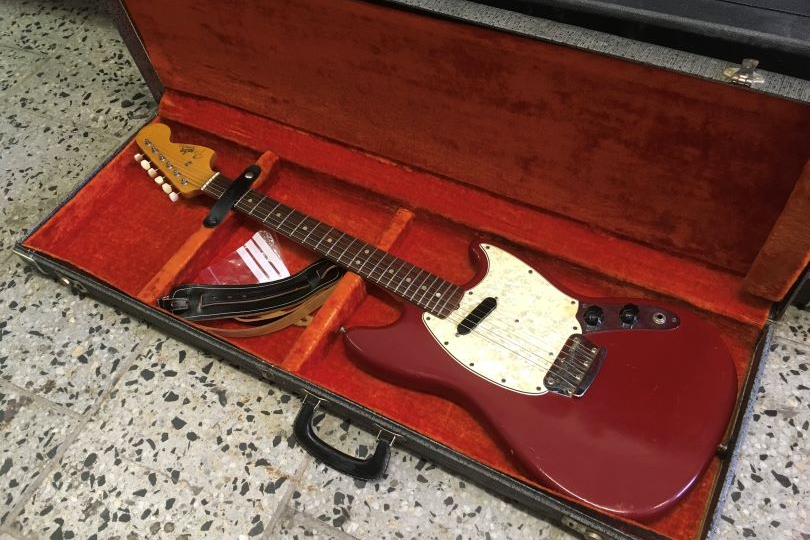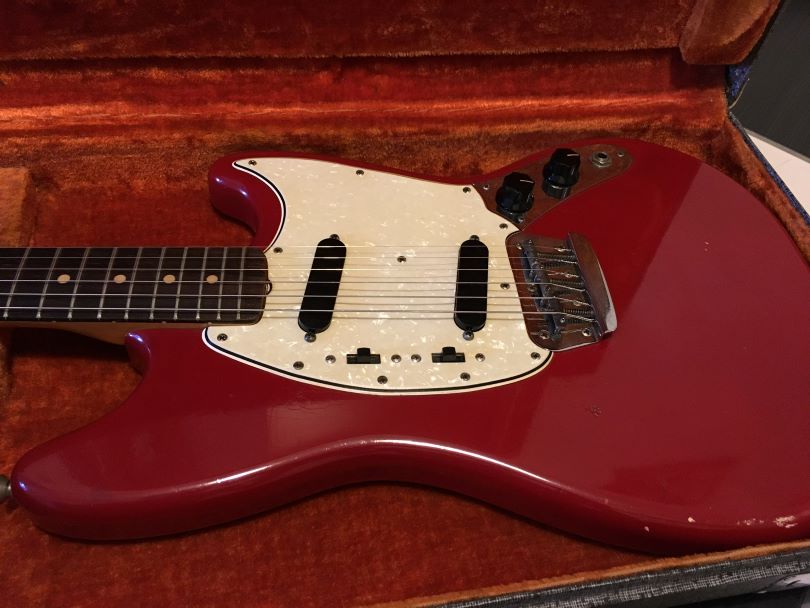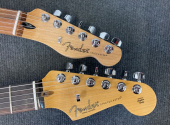
Under the Hood #30: Fender Musicmaster a Duo-Sonic
From the early 1950s, Fender guitars became increasingly popular. Many adult players embraced the Telecaster and Stratocaster, which were high-quality, professional guitars. But not everyone could afford them. This was either because of their price or the age of the player. Many kids in the middle of this decade were drawn to the new rock and roll wave and wanted to play too. But there wasn't much to play. So Fender put their heads together and the Musicmaster and Duo-Sonic student models were born.
The 1950s were a golden era for Fender. It was a time when groundbreaking guitar models were created and spread throughout the guitar world. There was also a very good business spirit at Fender. Leo Fender and others in management were able to pinpoint the needs of guitarists and other musicians and tried to adjust their range of products to meet those requirements.
After the first few years, more and more children and students were trying to play electric guitars. You can see photographs of young children with big instruments from this era. And that's where the business talent of the people at Fender came in. They believed that if someone started playing their guitars at a young age, there was a good chance they would stay with the brand. The idea was that kids and students would play smaller guitars which they would later trade in for adult professional models. And the theory was not wrong at all.
Two years after the launch of the Stratocaster, Fender introduced two student models within a short period of time.
Fender Musicmaster on stage for the first time
The first was the Musicmaster in April 1956. Before I start describing its specifications, I would like to point out one important thing. The term "student guitar" means nothing inferior at all in this case. On the contrary, the Musicmaster was made from the same materials and components as its pro counterparts, the Telecaster and Stratocaster. It was technically much simpler, but in terms of quality, it was comparable. This alone suggests that Fender took the production of these models seriously and stuck to its business vision. If the student models had failed, one could hardly assume that the guitarist would have stayed with the same brand of guitar.

Musicmaster specifications
As I have already mentioned, the Musicmaster was a much simpler or more minimalist model than its predecessors. The specifications and development of this model have been described in detail by Terry Foster.
If you were to play the Musicmaster, you'd first notice its size. The guitar had a 3-inch shorter scale. To compare, the Telecaster and Stratocaster were 25.5 inches, the Musicmaster was 22.5 inches. The explanation was simple. Children and students have smaller hands and as they are not comfortable playing an adult guitar, they may lose interest and show less progress. The shorter scale allowed them to play properly anything they wanted.
The neck profile was V-shaped in 1956, the same as the other models. The neck was still quite robust, which was common at the time. But the shorter scale made up for it.
The width of the nut was 1 ⅝ inch (about 41.2 mm), the Fender B designation. The neck was shorter but had a standard width at the nut, and its profile also conformed to the standards of the time.
The fingerboard had 21 frets, the neck was classic maple.
There were Kluson tuning machines just like on the other models – with the difference that they had plastic heads, which saved a few dollars in production.
The headstock was smaller than the regular models to fit the short neck and small body proportionally. The headstock had the classic Fender logo with the Musicmaster inscription on it.
The body of the instrument was made of ash in the first months of 1956, but later it was changed to alder. This change affected most Fender guitars. The paint colour was called Desert Sand and was a soft cream. The finish was done with nitro lac so the wood was not drowned and had a chance to age and play. The body had an offset shape, with two cutaways that were not so pronounced yet.
The pickguard was aluminium and its shape resembled a Precision bass. The electronics was entirely hidden underneath, which looked more elegant. The sound control was minimalistic, just volume and tone. Two potentiometers and nothing else. These had metal knobs, which looked very good with the aluminium pickguard.
And the pickup, one of the most important things on an electric guitar, was the same as on a Stratocaster, a standard single coil with a cream cover so you couldn't see the magnet poles. These were milled to fit under the cover. The pickup was in the neck position and was not perpendicular to the neck but angled, which was different to other models. This also contributes to its specific sound.
Based on all of these specifications, it is clear that this was a good-quality guitar with a friendly price, design and size. For young players, Fender guitars became more affordable and as a result, many of them developed a lifelong love for the brand.
Changes in design and construction
The Musicmaster had a life of its own and, like other models, underwent design or construction changes every year.
The first major change came in 1958 when the neck width was adjusted at the nut. It went from the B dimension to A, which in numbers is 1 ½ inch (about 38.1 mm). Therefore, the neck became smaller and narrower.
In 1959, Fender switched to rosewood fingerboards. The neck bracing was now installed before the separate fingerboard, eliminating the need to install the bracing from the back of the neck. The skunk stripe disappeared. In the same year, the lacquer colour changed to brownish-pink. The plastic pickup cover was now black and the pickguard changed from aluminium to plastic.
In 1961, the paint colour changed to sunburst. But it wasn't the same sunburst as the Stratocaster. The edges of the body weren't transparent, you couldn't see the wood and the colour was chestnut brown. The 1963 model was also available in white.

1964 and redesign
In 1964, Fender introduced the Mustang model, and with it, the Musicmaster changed. The Musicmaster ll inscription on the headstock indicated a new generation of the model.
The pickguard was now split into two parts, with the plastic part covering the pickup and the metal part covering the potentiometers. This is the same on all models, i.e. Musicmaster, Duo-Sonic and Mustang.
The shape of the bridge was altered significantly, it was larger and no longer had a metal cover.
From this year, the Musicmaster was sold also with a longer 24-inch scale. So there are two scale versions available, the old 22.5 and this longer one, which is more comfortable for older players. The models are described as ¾ scale or full scale.
The paint colour was red, blue or white and was still nitro lac.
Student models of Fender guitars were heavily influenced by the great popularity of the Mustang. The Musicmaster model was sold continuously until 1982.
The price of Musicmaster
In 1957, Musicmaster cost 119.50 dollars. From 1960 to 1965, it was sold for 129.50 and by the end of 1965, the price changed to 126 dollars + 34 dollars for the case. In 1970, it cost 162.50 and by 1977 it was 220 dollars. More detailed price differences by year are shown here.

Duo-Sonic two-pickup version
In 1956, two months after the Musicmaster, Fender launched the Duo-Sonic, which is a Musicmaster with one extra pickup. The only difference in production was that the factory put in a different pickguard, supplemented by a bridge pickup and a three-position pickup switch.
The bodies of the two models were identical, which saved costs in production. We can find a shaft for the pickup and the pickup switch under the pickguard of the Musicmaster. If someone got tired of the single pickup version, they could just swap the pickguard for the version with the second pickup.
The neck pickup was still angled, but the bridge pickup was perpendicular to the bridge. This arrangement was exactly the opposite of the Stratocaster. Therefore, the student models had slightly different sound.
The changes for Duo-Sonic were the same way as those for Musicaster, so there is no need to list them. The difference is in the overall production time, the Duo-Sonic was available until 1969, ending thirteen years earlier than the Musicmaster.
As Rod Brakes nicely described in his article, the Musicmaster, Duo-Sonic and Mustang are essentially the same guitars, with each successive model always having something extra over the previous one. The Duo-Sonic has an extra pickup, the Mustang has an extra tremolo bridge.
To conclude
Both student models found their rightful place among Fender guitars and to this day, many guitarists, me included, can't get enough of them. However, the 22.5-inch models look a bit juvenile from today's perspective, and the very short scale is not suitable for every player. However, they are generally playable. And most importantly, they are the only guitars from Fender's golden era that can still be found for a reasonable price.
If you have found an error or typo in the article, please let us know by e-mail info@insounder.org.


